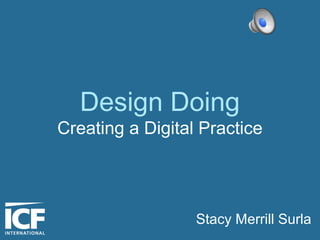
Design Doing: Creating a Digital Practice
- 1. Design Doing Creating a Digital Practice Stacy Merrill Surla
- 11. Gabrielle
- 12. Juhan Sonin
- 14. VOLTE
- 17. Journey Mapping Mental Modeling Business Origami 10+10 Brainstorming Cross Channel Heuristics
- 18. Keoni Cabral
- 19. Ashley Rose
Hinweis der Redaktion
- I want to start with a story told by a client of ours named Erik. He took his dog to the vet for urgent care, and the receptionist looked up the information by the dog’s name — not Erik’s.
- Then, in a seamless hand-off, the information, and the patient, were transferred to the vet in the exam room. Erik didn’t have to repeat a thing to anyone. All the information and attention followed the dog.
- The vet’s office followed up through email, phone calls, and texts. They even set up the dog’s prescriptions for him! They knew their actual end user.
- Isn’t that what we do as Information Architects? We figure out who the real user is and design solutions for that user.
- What if our workplaces were designed to support all our colleagues working together, to solve problems? As IAs, we can use our ways of thinking and working to transform our businesses. We can make them better at solving the problems of the connected world.
- And make them more fun and fulfilling places to work. But it’s not just about fun. Because now the big problem is not how to make websites work. The big problem is creating connected experiences across digital and traditional channels.
- Unfortunately, too many workplaces don’t understand what you do beyond making wireframes. Take Jane, the IA. She’s valuable because she sees the big picture AND the little pieces.
- Jane’s true superpower is she can change the game with her IA thinking and doing. What would happen if you could plug that superpower into your business? What if you could change the entire design of how you and your colleagues work?
- Right now no matter what company you go into, they most likely have a poor design for how to solve problems and create meaningful change. You have design by committee. You have design by afterthought. You have design by fear of the consequences.
- But as IAs, we can bring a better, more innovative, and more fulfilling design: Design by doing. It’s what my group is bringing into the picture, not only for our clients but within the company itself.
- We’re doing a project for Erik that uses websites, social media, text messaging, and mobile apps to help people stop smoking. The next challenge is to build connected experiences for quitters that cross online and offline channels.
- No requirements session is going to solve that level of problem. We have to get the clients and the team to actually do the work of design. This is design by doing.
- Erik’s story about his dog came out of a design doing workshop. His staff shared examples of great, or terrible, customer experiences. And then THEY saw what they want in their quit smoking program. Like empathy, and information that follows along WITH you.
- Here’s more about some tools we use. The Volte we did with Erik is a way to solve big problems by baking in client participation. It includes deep dives into gathering and discerning, and a Shape workshop to craft the way forward.
- Innovation Mining. To uncover project innovation in the company. We’re also digging for where innovation should be happening, but isn’t. Hack Days. Competitions where cross-disciplinary teams solve real client problems, and win fabulous prizes.
- Dry Runs. For instance we’re training ourselves to deliver rapid working code, in one-day or even one-hour sprints. It’s like LeanUX improv.
- Journey Mapping Business Origami Cross-Channel Heuristics. Use methods like these to bootstrap your way to becoming an agent, or architect, of change. I’ll provide a link to a handout on how these tools work.
- You might be saying at this point, though, “This sounds well and good, but I’m just one person in a big bureaucracy.” It’s scary to be in your position. You want it to work, but do you have the power to make your business better at solving problems?
- You do. You have your IA thinking. Your methods and concepts are tools in your utility belt.
- Do not fear to use your superpowers. Trust your point of view, your vision of what’s important and what’s next. And create a Design Doing work environment. Where all your crazy and beautiful ideas become the normal way to work.
